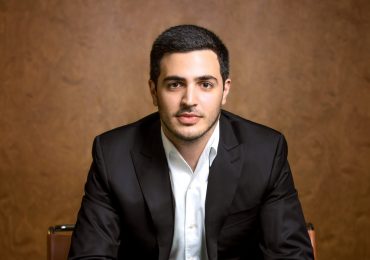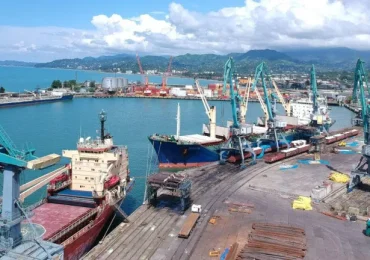“2016 is going to be a very successful year for tourism. It’s hard to predict the numbers, but we can safely say that Georgia will be hosting at least 6.3 million tourists this year,” said head of Georgia’s National Tourism Administration Giorgi Chogovadze at the end of his interview with Forbes Georgia. Chogovadze made no attempt to hide the obvious – in 2016 tourism has become a much larger priority for the Georgian Dream government than in it was previous years.
In just the first five months of 2016, the number of international tourists in Georgia reached a total of 2.1 million, which is 15.3% more than in the same period of last year. From January-May 2016, 782,814 tourists entered Georgia, an 18.8% increase. During this five-month period, the majority of them came from Ukraine (23.8%), Azerbaijan (22%), Armenia (2.8%) and Russia (19.6%).
According to the official data provided by the National Tourism Administration (NTA), this upward trend can also be attributed to the increased number of visitors hailing from EU member states. In January-May 2016, there was a noticeable increase in the number of tourists coming from Latvia (+35%), Italy (+22%), Poland (+15%) and France (+10%).
There has also been a documented increase in the number of visitors originating from countries like India (+335%), Oman (+329%), Israel (+113%), the United Arab Emirates (+69%), Belarus (+46%), Uzbekistan (+41%), Kazakhstan (+25) and Moldova (+22%). In addition, the Georgian government’s decision to relax the visa regime with Iran earlier in this year has had an immediate impact on the number of visitors coming to Georgia from Iran.
Despite the fact that the Georgian government did not take into consideration NTA Head Giorgi Chogovadze’s position when they decided to tighten visa restrictions for Iranian citizens a few years back, Chogovadze is glad that the government has since reconsidered the move by once again loosening the visa regime, and making travel easier.
In only five months of 2016, Georgia hosted 25,552 visitors from Iran, a 361% increase compared to the same period the previous year. ForbesGeorgia spoke with a few Iranian tourists who were walking on Shardeni Street recently, and they explained that Georgia is attractive to them because of its interesting and ancient culture, freedom, and the country’s European style laws.
“Compared to Armenia and Azerbaijan, this country is much closer to Europe. People tend to be very open and sociable here. At first, I decided to come to Georgia because my friend highly recommended it. I really liked it, and now this is my second trip to Tbilisi. Since I arrived, I have traveled to Kakheti, and I have to say, it’s really a very beautiful place,” says Rahim Nassir Baghebani, theDirector of the Ronash Fars Sefid company. Baghebani says he plans to visit Georgia a third time, but this time it will be a business trip.
Georgia is the 107th country visited by 74-year-old Iranian Rauf Mareful. “You have a very interesting country. I plan to return here, if you find me a beautiful Georgian girlfriend,” says the Iranian tourist jokingly, as he pointed out the things that make foreign tourists feel uncomfortable here. He cites traffic jams, parking problems, the lack of public bathroom facilities in tourist zones and beggars.
“I could not walk freely on Shardin Street. A child grabbed me by the feet and would not let me go until I gave him money. Then a second child came out of somewhere and asked for money. I heard that these beggars are not Georgians, but this does not change anything. They are not afraid of the police. This is a problem and the government should try to solve this problem somehow,” explained Mareful with a touch of an anger in his voice.
The NTA is well aware of these problems and knows that the government needs to take measures to solve them. Chogovadze says that they are working with the Ministry of Interior now to resolve these issues. “In many cases, these are not just people who ask for money, but their behavior is on the verge of hooliganism. Unfortunately, at this stage, we do not have the legislation in place to effectively deal with this problem,” Chogovadze notes.
Those who have had an opportunity to observe how the infrastructure and priorities of the Georgian tourism sector have developed over the past few years, have a milder approach to such problems. Country Director for Steppes Travel, Paul Craven is one of them. He has 15 years of experience arranging trips to Georgia. He told ForbesGeorgia that the country has undergone major changes during this time.
“There was a lack of decent accommodation, the electricity supply was often interrupted, and the roads were in poor condition. The roads are much better now, which means there are less travel-related inconveniences for visitors, and they can see more things. Visitors can stay at a number of international hotels in Tbilisi, Borjomi, Batumi and some other cities. There are small hotels and guesthouses everywhere,” says Craven, who is originally from Great Britain. However, Craven acknowledges that there are some problems that remain unsolved. “There are no direct flights from the United Kingdom to Georgia, and flights from other locations operate very late. Elderly people find it hard to navigate the streets here as well, and in most places, it’s almost impossible to get around in a wheelchair,” he notes.
NTA Head Giorgi Chogovadze told us that the government is already working to solve a majority of these problems.
“Today the infrastructure in Tbilisi and Batumi is more geared towards accommodating disabled tourists than in other parts of the country. However, we’ve identified certain places in Kakheti where we can arrange tours for those with disabilities. By the end of 2016, the infrastructure of Mtskheta will be fully adapted to receive tourists with disabilities. Additionally, we are currently working on a project to improve the infrastructure in Tskaltubo in order to make it a desirable recreational destination for visitors with disabilities,” says Chogovadze.
Furthermore, in order to allow tourists to travel more comfortably in the various regions of Georgia, the National Tourism Administration plans to build rest areas on highways, like the one in Gori.
“We are planning to build rest areas in the following three main routes: Tbilisi-Kakheti, Tbilisi-Kazbegi and Tbilisi-western Georgia. At the initial stage, the infrastructure will be built by the state, since the private sector will have less interest. However, in the future, these facilities might be handed over to private businesses for management,” Chogovadze explains.
Improvement in the quality of service is another challenge that needs to be tackled, and this time it is the prerogative and responsibility of the private sector to accomplish this. The NTA provides small and medium businesses with occasional training courses for employees. However, representatives of the private sector believe that development of the tourism industry requires an increase in tourist flows at a faster pace, and this requires targeted marketing campaigns.
Head of the Gudauri Heli-Skiing Tour Company Vakhtang Asatashvili told Forbes Georgia that Eastern Europe, Asia and North America remain untapped markets for Georgia that have lots of potential.
“Businesses tend to increase their services when there is an increased demand for a particular service on the market. Despite the fact that there is a lack of qualified workers in our country, small and medium businesses are reluctant to risk and develop their activities until the customer comes knocking on their door. In order to create additional jobs, generate economic growth and develop small and medium businesses, our government needs to ensure steady growth in tourism. At the present, the government’s resources are largely concentrated on the Russian market. But rather than preventing risks, this growing dependency on the Russian market is actually creating more risks,” notes Asatashvili.
In fact, according to the official data, most of the NTA’s marketing campaigns are aimed at former Soviet states like Russia, Ukraine, Azerbaijan, and Kazakhstan. However, there are online ads about Georgia available in Italy, Germany, Israel, Kuwait, Qatar and the United Arab Emirates.
Can you justify the strategy to spend most of your resources on marketing campaigns that target the traditional markets where awareness about Georgia is already high? Chogovadze believes you can, and brings up the example of Ukraine.
“Many countries have actually experienced a significant decrease in the number of tourists from Ukraine, while we have managed to maintain the same figures in 2015,”Chogovadze notes in response to the critics, who often criticize his administration for its lack of effort in trying to enter new markets.
“The marketing campaign becomes less effective if it does not offer visa-free travel, direct flights and country awareness. It’s hard to convince a European to travel to Georgia via a connecting flight. The reality is that we do not have direct flights to and from most European cities. Therefore, we work very closely with the airlines, since their passengers are our tourists. For example, in September Wizz Air plans to launch direct flights to Milan, Berlin and Munich. As such, we are planning to kick-off marketing campaigns in these cities,” explains Chogovadze.
Former head of the National Tourism Administration Maia Sidamonidze also emphasizes the importance of market diversification. Sidamonidze believes that since more than 80% of Georgia’s visitors come from neighboring countries, this approach can be used both in a positive and a negative way.
“The current conflict between Russian and Turkey turned out to be advantageous for us. However, the devaluation of the national currencies in the region, which occurred this winter, had a negative impact on the country’s revenue derived from tourism. Therefore, any political or economic developments in the region have a direct impact on Georgia’s tourism market,” says Sidamonidze.
Based on the available statistics, revenue derived from foreign tourism is constantly growing. In 2015, this figure reached $1.9 billion. The share of tourism in the export of services increased from 40% to 61% in the last five years.
“Just providing figures – in this case $1.9 billion –does not tell us anything. We also need to know where it came from, and where it went. It is impossible to carry out a long-term plan or attract foreign investment without having detailed information. It is absolutely necessary to calculate the share of transportation, accommodation, food and entertainment in the tourism-generated revenue figures. This is the only way we can identify the growing and profitable sectors,” says Vakhtang Asatashvili. Sidamonidze agrees with Asatashvili, and emphasizes the need for regional studies to determine the load factor and revenue based on various regions.
NTA Head Giorgi Chogovadze does not deny the need for detailed, broken down data. He told Forbes Georgia that the National Statistics Office of Georgia is currently conducting a study and the results will be published in September. The study will include information regarding purpose of the visit, popular destinations, average duration of the stay and a traveler’s average expenditure during the trip.
And while the private and state sector wait for the results of the study, the statistics show that there are total of 158,500 people employed in the tourism sector. 25,100 of them are employed by hotels and restaurants, 89,200 work in transportation and communications (excluding pipeline transportation) and 44,300 provide other types of services, all of which is proof that Georgia’s growing tourism industry should not be disregarded.

















